Cleaning your espresso machine regularly is key to great coffee and machine longevity. Use cleaning tablets like Urnex Cafiza for backflushing to target coffee oils. Descaling tablets, such as Urnex Dezcal, effectively remove mineral buildup. While citric acid is an alternative, it may not be as effective for oils. Always check product safety and manufacturer recommendations. If you want to know more about best practices and maintenance tips, there’s plenty more to explore.
Key Takeaways
- Cleaning tablets, like Urnex Cafiza, effectively target coffee oils and residues, ensuring optimal espresso machine performance during backflushing.
- Descaling tablets, such as Urnex Dezcal, are crucial for removing mineral buildup; use them every three months or as needed.
- Alternative products, like citric acid, can work for descaling but may not efficiently clean coffee oils compared to dedicated tablets.
- Always check the safety of alternative cleaning products, as some may damage machine parts; use manufacturer-recommended tablets for best results.
- Regular maintenance, including rinsing components and using water filters, complements the use of cleaning tablets for optimal machine longevity.
Importance of Regular Cleaning for Espresso Machines
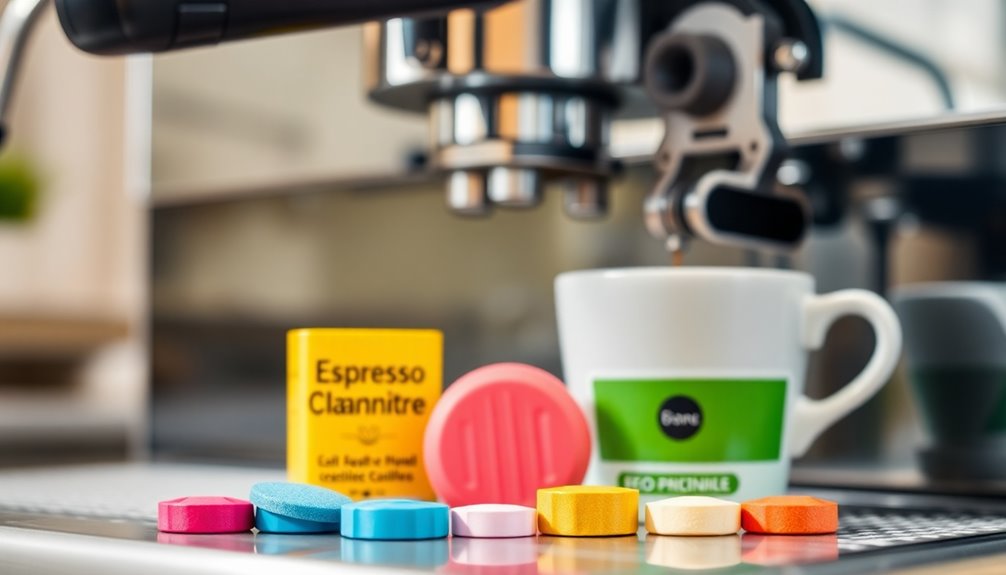
When you neglect the regular cleaning of your espresso machine, you risk not only its performance but also the quality of the coffee it brews.
Coffee oils and mineral deposits can build up, negatively impacting flavor and efficiency. To maintain peak functionality, you should descale your machine every three months or more often if your water quality is poor.
Regular descaling every three months is essential to prevent coffee oils and mineral deposits from compromising flavor and efficiency.
Back flushing once or twice a month helps eliminate coffee residue and oils from the brew head and portafilter.
While many machines have automated cleaning cycles, using espresso machine cleaning tablets like Urnex Cafiza is essential for thorough maintenance.
Following manufacturer recommendations guarantees you keep your machine in top shape and maintain warranty coverage.
Regular cleaning is key to great coffee! Additionally, using high-quality brewing capabilities ensures that your machine consistently delivers optimal flavor and performance.
Overview of Cleaning Tablets and Their Functionality
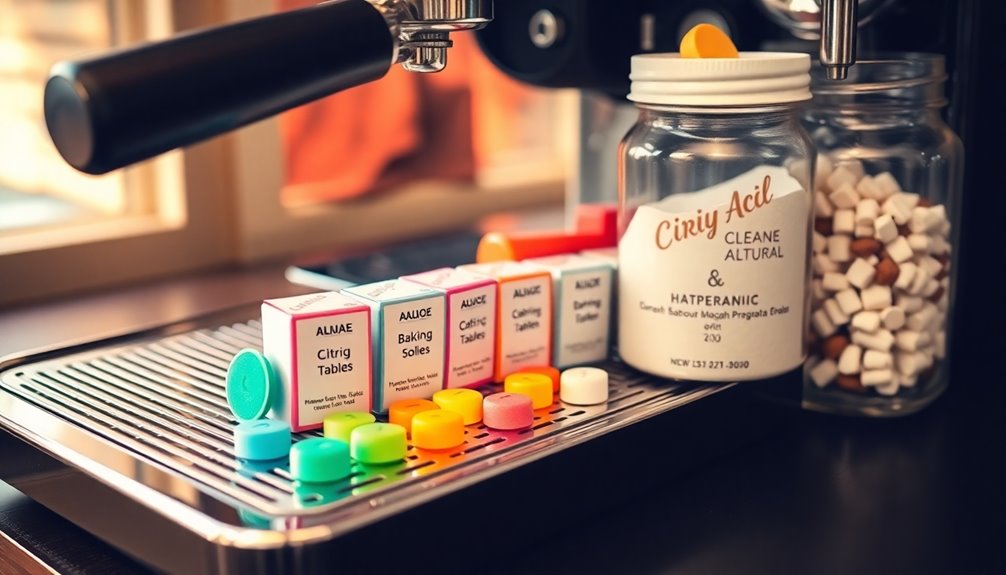
When it comes to cleaning your espresso machine, understanding the different types of cleaning tablets is crucial. These tablets are designed to effectively tackle coffee oils and residues, unlike common household products that mightn’t be safe for your machine. Plus, you’ll want to take into account safety guidelines to guarantee you’re using the right product for peak performance. Utilizing innovative solutions can help streamline your cleaning process and enhance the longevity of your equipment.
Types of Cleaning Tablets
Cleaning tablets for espresso machines play an essential role in maintaining the quality of your brew, as they’re specifically designed to tackle coffee oils and residue buildup.
Products like Urnex Cafiza are formulated for backflushing, guaranteeing peak brewing performance by eliminating buildup in the brew group and portafilter.
Here are some types of cleaning tablets you might consider:
- Urnex Cafiza: Ideal for cleaning espresso machine components.
- Proprietary Tablets: Brands like Breville offer specific options for their machines.
- Descaling Tablets: Such as Urnex Dezcal, designed to remove mineral buildup.
- Steam Wand Cleaners: Specialized for milk systems.
- Regular Cleaning: Recommended every 500 drinks or monthly to maintain flavor.
Using these cleaning tablets helps guarantee your espresso remains delicious! Additionally, maintaining air quality in your brewing environment can further enhance the overall flavor of your coffee.
Effectiveness of Alternative Products
While traditional cleaning tablets are specifically designed for espresso machines, alternative products can also be effective in maintaining your equipment.
For instance, citric acid can help remove mineral buildup during the descaling cycle, similar to how Urnex Dezcal works. These alternatives may not target coffee oils as effectively as dedicated cleaning tablets like Urnex Cafiza, but they can still provide a cleaning boost.
However, using products like denture tablets requires caution, as they might damage seals and internal parts. If you choose to go the alternative route, verify that the product is safe for your machine.
Ultimately, while cleaning tablets offer tailored solutions, alternative cleaning products can also contribute to your espresso machine’s upkeep when used carefully. Additionally, using proper airtight containers for storage can help maintain the quality of your espresso machine’s components.
Safety Considerations for Users
Understanding safety considerations is essential for anyone using cleaning tablets in espresso machines, as these specialized products play an important role in maintaining both performance and flavor quality.
Always choose manufacturer-recommended cleaning tablets, like Urnex Cafiza or JURA Cleaning Tabs, to effectively remove coffee oils and residues.
Here are some safety tips to keep in mind:
- Review safety data sheets (MSDS) for handling instructions.
- Be aware of potential hazards associated with the chemicals.
- Use gloves and goggles to protect yourself during cleaning.
- Avoid mixing cleaning tablets with other substances.
- Regular use helps prevent unwanted flavors and maintains peak performance. Additionally, ensure that you follow proper cleaning procedures to avoid damaging your espresso machine components.
Alternatives to Cleaning Tablets

If you’re looking for alternatives to cleaning tablets, citric acid is a strong contender for breaking down calcium buildup and often comes at a lower price. You might also consider a vinegar-water mixture, though it’s best to use this method cautiously with your espresso machine. Exploring these options can help keep your machine in top shape without relying solely on commercial tablets. Additionally, it’s important to regularly check for signs of buildup to ensure optimal machine performance.
Citric Acid Benefits
As you explore alternatives to traditional cleaning tablets, you’ll find that citric acid stands out as a highly effective option for maintaining your espresso machine. This natural cleaning agent excels at descaling your machine, effectively dissolving mineral buildup without the unpleasant odor associated with vinegar.
Here are some benefits of using citric acid:
- Cost-effective and easily available online
- Prevents unwanted flavors in your coffee
- Maintains peak machine performance
- Extends the lifespan of espresso machines
- Simple to use for regular maintenance
Incorporating citric acid into your cleaning routine can enhance your espresso experience, ensuring your machine operates at its best while keeping your coffee tasting great. Additionally, using citric acid aligns with regulatory frameworks that encourage safe and effective cleaning practices.
It’s a smart choice for anyone serious about their brew!
Vinegar-Water Mixture Method
When you’re looking for a simple and cost-effective way to clean your espresso machine, the vinegar-water mixture method can be a great alternative to commercial cleaning tablets.
To use this method, fill the water chamber with equal parts white vinegar and water. This effective solution helps clean and descale your espresso machine.
For best results, pause the brew cycle for 30 minutes to an hour before completing it. After brewing with the vinegar solution, flush the machine with clean water to remove any residual vinegar taste.
However, keep in mind that vinegar isn’t recommended for automatic espresso machines due to potential damage to seals. Always follow your manufacturer’s guidelines to protect your equipment. Additionally, be mindful of essential oil safety when using any cleaning agents to ensure safe handling and prevent any adverse reactions.
Step-by-Step Guide for Using Cleaning Tablets
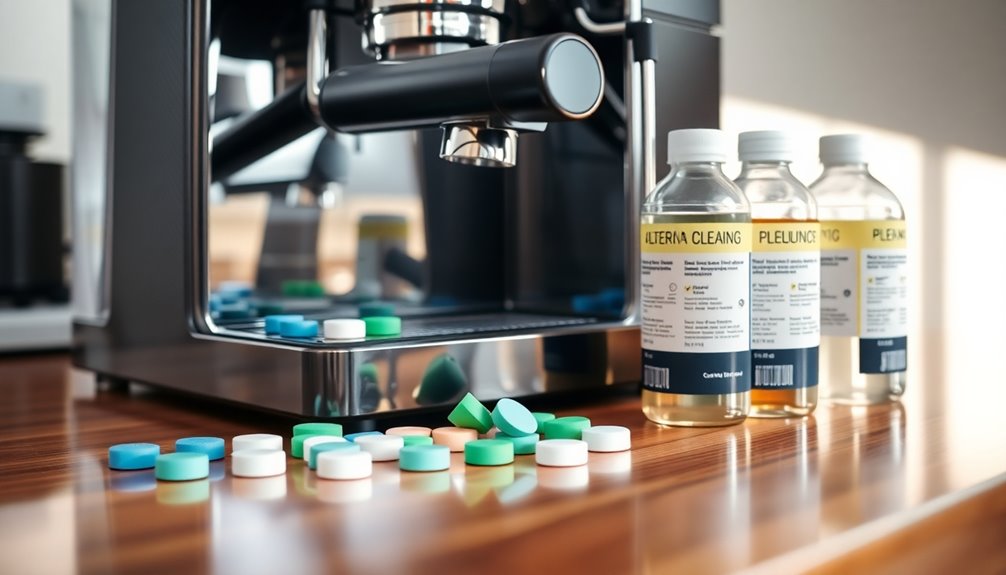
To make sure your espresso machine stays in top shape, start the cleaning process with cleaning tablets after confirming that it’s powered off and cooled down.
For machines with a backflushing feature, insert a blind basket into the portafilter and add the cleaning tablet according to the manufacturer’s dosage instructions.
Run a backflush cycle as specified in your machine’s manual, pausing for 10-30 seconds. This allows the cleaning solution to break down oils and contaminants.
After completing the cycle, rinse the portafilter and brew group by running clean water through the machine.
- Check the machine’s manual for specific instructions
- Use the correct dosage of cleaning tablets
- Make sure the machine is cooled down
- Rinse thoroughly with clean water
- Repeat regularly every 500 drinks
Additionally, maintaining optimal image quality in your home cinema can enhance the overall experience while enjoying your coffee.
How to Maintain Your Espresso Machine Between Cleanings
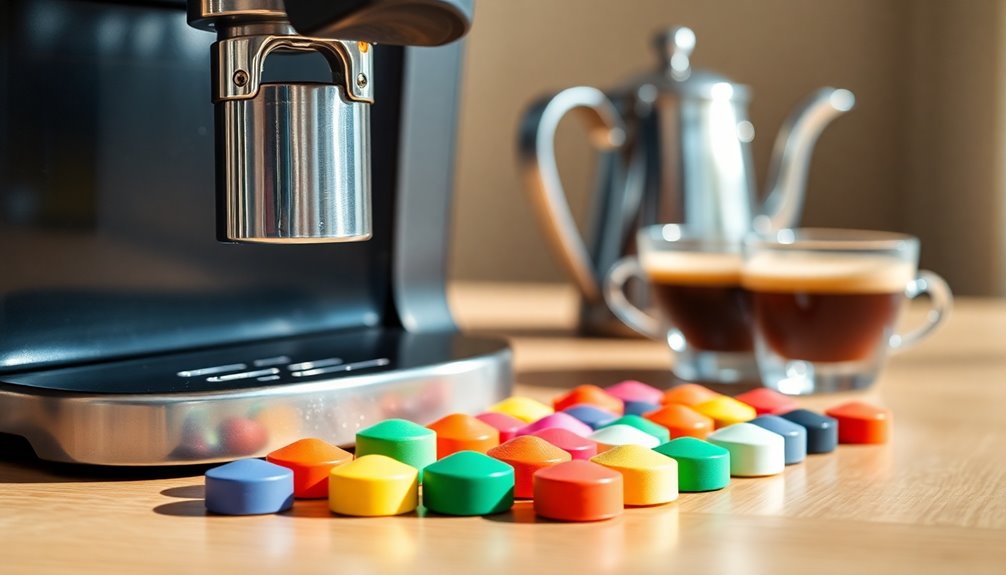
Maintaining your espresso machine between cleanings is essential for ensuring consistent performance and flavor.
Start by emptying and rinsing the dregs drawer and drip tray after each use to prevent coffee grounds and oils from building up.
Rinse the brew group under warm water weekly to remove residue for ideal extraction.
Clean the water tank and milk system daily to avoid mold growth, especially in coffee makers with milk frothing capabilities.
Regularly wipe down the exterior to eliminate dust and spills that can cause corrosion.
Finally, always use a water filter for brewing to reduce mineral buildup and prolong the time between descaling sessions. Using advanced filtration systems can significantly improve the quality of your water and enhance your espresso’s flavor.
This simple routine will help you clean your coffee machine and maintain its longevity.
Best Practices for Descaling Espresso Machines
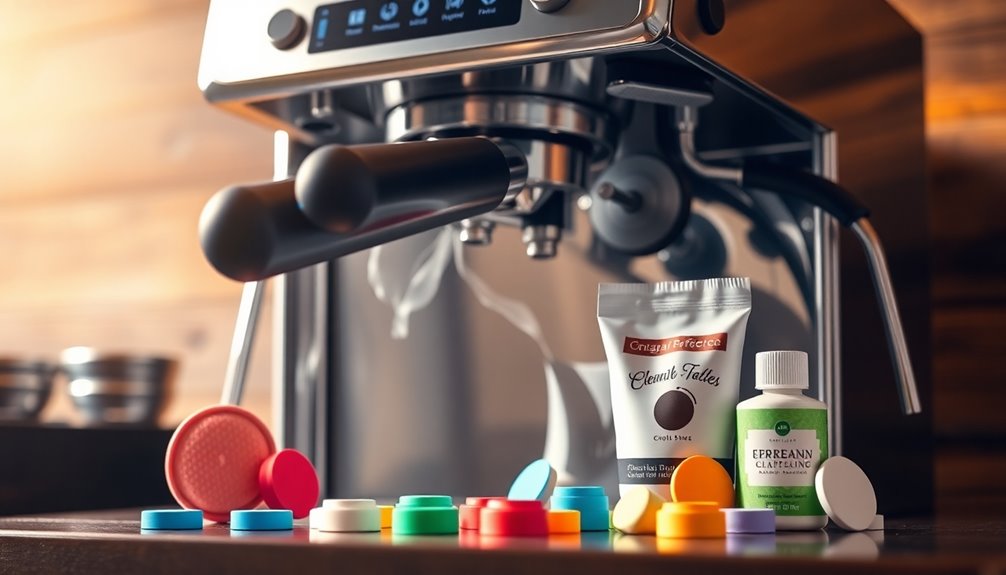
Descaling your espresso machine is essential for keeping it in top condition and ensuring a great coffee experience. You should descale approximately every three months, or more often if you use hard water.
Following your manufacturer’s guidelines for descaling frequency and recommended products is vital. Use products like Urnex Dezcal or Durgol Swiss Espresso Descaler, as they effectively dissolve scale without harming your machine.
Avoid vinegar, as it can affect the taste of your coffee and damage seals. Many coffee machines have indicators to remind you when it’s time to descale, making maintenance easy.
- Descale every three months
- Use Urnex or Durgol
- Avoid vinegar
- Check for indicators
- Follow manufacturer’s guidelines
Frequently Asked Questions
What to Use Instead of Espresso Machine Cleaning Tablets?
If you’re looking for alternatives to espresso machine cleaning tablets, consider using citric acid, which effectively dissolves mineral deposits.
A simple mix of half white vinegar and half water can also work well—just let it sit for 30 minutes before brewing.
Urnex Cafiza is a great commercial option designed specifically for espresso machines.
You can even use denture cleaning tablets, as they help break down coffee oils and residues.
Always check your manufacturer’s guidelines first!
What Can I Use to Clean My Espresso Machine?
To clean your espresso machine, you can use specialized cleaning tablets designed for this purpose, like Urnex Cafiza.
If you prefer alternatives, citric acid works wonders in dissolving mineral deposits without the strong smell of vinegar.
Regular backflushing with these tablets monthly helps maintain peak performance and prevents buildup.
Just remember, avoid vinegar, as it can damage seals and affect the taste of your coffee.
Always follow your machine’s manufacturer guidelines for the best results.
What Is a Good Substitute for Descaling Solution?
Think of your espresso machine as a garden; it needs care to flourish.
For descaling, citric acid is a fantastic substitute, acting like sunlight breaking through the clouds, dissolving mineral buildup effectively.
You can also mix equal parts of vinegar and water, a simple yet powerful solution.
How to Clean an Espresso Machine Without Tablets?
To clean your espresso machine without tablets, mix equal parts vinegar and water, then run a brew cycle and flush with clean water afterward.
You can also use citric acid mixed with water to tackle mineral deposits.
Regularly backflush with water using a blind basket to clear coffee oils from the brew head.
For a natural option, dissolve denture tablets in water and run that through the machine to break down buildup effectively.
Conclusion
Keeping your espresso machine clean is like tuning a musical instrument; it guarantees every cup hits the right notes. By regularly using cleaning tablets or exploring alternatives, you can maintain the quality of your brew. Don’t forget to follow best practices for descaling and general maintenance between cleanings. A little effort goes a long way in preserving your machine’s performance and extending its life, so you can enjoy perfect espresso every time you brew.










